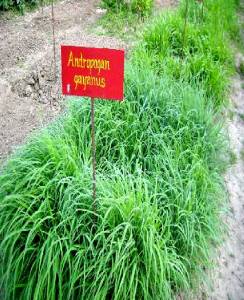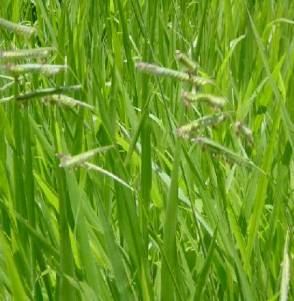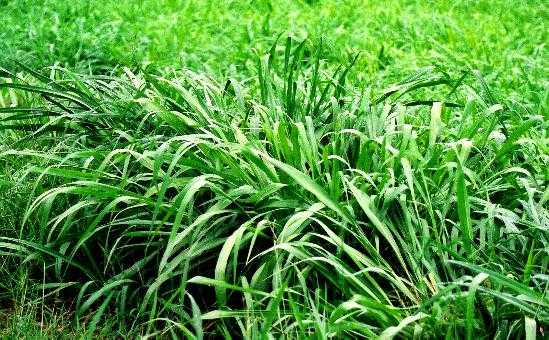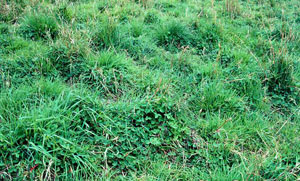|
Forage grass
This forms the most common natural herbage for the herbivorous animals. This is
a very large, cosmopolitan group of grasses. Most grasses are herbaceous, small,
erect or prostrate. Some are annuals and some perennials, suited to humid, tropical,
sub-tropical or temperate areas. The general habit, yield, other characters, etc.
of forage grasses, legumes and cereals suitable for Kerala conditions are given
separately in Cultivated Forage Grasses
Andropogon gayanus (Gamba grass) . Also known as ‘sadabahar’.
This is a native to tropical Africa. It is a tall tussock grass and is adapted to
a variety of soils from sandy to clay soils. It is a good grass for drier region.
It tolerates deep seasonal flooding.
The crop can be propogated through rooted slips or seeds lightly drilled.


(Source: FAO)
Brachiaria decumbens (Signal grass)
This is native to Uganda and adjoining east African countries. This is a vigorous,
trailing perennial grass. Erect shoots develop from a long, prostrate stolon. This
grass is adapted to humid tropical areas of rainfall not less than 1500 mm. Propagation
is by seed and by slips.


(Source: FAO)
Brachiaria mutica (Para grass)
Also known as buffalo grass./water grass/ Angola grass/Mauitius grass.
This is a native to tropical Africa and South America. Para is a rather coarse and
vigorous perennial grass spreading by means of stout stolons which root and branch
readily at all nodes. Important characteristic of para grass is its adaptability
to wet conditions, water logging and prolonged flooding. Propagation by slips or
stem cuttings.
Propogated by slips or stem cutting-27000 to 40000 slips/ha.
Seed rate: 2.5- 3.5 kg/ha
N: P2O5: K2O- 40: 30 : 30, FYM-40 t
Harvested: 3 months after planting when grass attains 60-75 cm
Annual yield: 70t/ha

(Source: FAO)
Brachiaria ruziziensis (Ruzi grass or
Congo signal)
This is a native of African Congo; vigorous, prostrate to semi-prostrate, perennial
and leaves are soft, covered with fine hairs and sharply pointed. Under Kerala conditions,
it has a long vegetative growing period and flowering in September-October and seed
maturing in December. Under grazing system it forms a dense mat. The grass is palatable,
withstands grazing well and produces high dry matter yields. Water requirement is
high. Propagation is by seed, slips and stem. It does not tolerate water logging.
Being shade tolerant, suitable for intercropping in coconut gardens.
Seed rate: 2-5 kg/ha.
N: P2O5: K2O- 100-150: 50 : 50, FYM-5 t
Harvested after 50 days after planting and subsequently at 30-40 days interval.


(Source: www.institutohorus.org)
Cenchrus ciliaris (Buffel grass)
This grass is summer growing, deep-rooted, perennial, drought tolerant rough, hairy
and having good persistence against heavy grazing and burning. This is best suited
for areas of rainfall of less than 1000 mm.


(Source: FAO)
Panicum maximum (Guinea grass)
Popular fodder crop of tropics suited to agroclimatic condition of Kerala.
It is a tall growing perennial forming dense tillers, which enlarge by short rootstocks
or short creeping rhizomes. Leaves are long and broad. This grass is adapted to
a wide range of soils and is drought and shade tolerant. Propagation is by seed
and slips. The grass is recommended for cultivation in coconut gardens.
Varieties: Makueni, Riversdale, Hamil, PGG-4, FR-600, Haritha, Marathakam and Harithasree
Makueni is a drought resistant cultivar suited for rainfed condition.
Seed rate: 3 kg/ha
Propogation by seeds or slips
Spacing: 40 cm x 20 cm
N: P2O5: K2O- 200: 50 : 50, FYM-10 t
Harvested when plant reaches 1.5 m height

(Source: FAO)
Setaria anceps (Golden timothy)
Setaria forms dense tillers and spread by short rhizomes. Leaves are long, thin
and hairless. This is very much acceptable to cattle and has high digestibility.
This is relatively frost tolerant and also withstands water logging to some extent.
Propagation is usually by seed.
Varieties: Nandi, Narok, Kazungala
Spacing: 50 cm x 30 cm
Slips: 33500-67000 per ha
Harvested after: 9-10 weeks

(Source: www.agrocosta.com.br)
Melinis minutiflora (Molasses grass)
This grass, a native of tropical Africa requires a minimum rainfall of around 1000
mm. This is a tufted leafy perennial with loose trailing stems which may root from
the lower nodes. The stems form a dense struggling mat. Leaves are flat, short,
flushed red-green in colour and covered with hairs which exude a secretion with
a strong molasses odour. It is suited for cooler climate.


(Source: FAO)
Pennisetum typhodieu purpureum (Hybrid
Napier)
This is a cross between elephant grass and bajra. It is a native to Africa. It can
be successfully propagated vegetatively in areas having minimum around 1500 mm annual
rainfall and temperature range of 30°–35°C. Propagation is by stem cuttings, rooted
stem and slips and never by seeds. Under sewage irrigation it can yield over 300
tonnes per hectare. Co2 and Co3 are the recent promising varieties.
Hybrids: Pusa Giant Napier, Gajraj, NB-5, NB-6, NB-21, NB-35, Suguna, Supriya
Spacing: 60 cm x 60 cm
N: P2O5: K2O- 200: 25: 50, FYM-25 t
First harvest : 9-10 weeks after transplanting
Yield: 200-250 t/ha

Top
|